Swimming
in
Categorization
Abstract
This research started with the following question: what is the way to go in the direction of the best design decision without falling into the swamp of dangers of categorical thinking? We all categorize everything, simplify and judge it based on that categorization and this instinctively happens in surviving. Therefore, categorical thinking comes naturally to us, but it easily leads to judgment wrapped by prejudice. In particular, categorical thinking has the danger of stereotyping individual identity as group identity and judging it. For example, in the “Curtain” project I did in my first year, my research was based on the specificity of a certain group. While conducting research on the question “Why do Dutch people live without covering their curtains?” I realized that the shape of curtains differed according to individual taste, not specific ethnicity. We believe in ourselves that we do not categorize. However, this is delusional. Then in order to have the right direction of design without prejudice, shouldn't we be aware of the categorical thinking that has the potential to result in the wrong idea and make our eyes blind? I conducted this research in the hope that my personal experiences and history will become a tool for reflection and reconstruction for readers with the same concerns.
So, first, I explained different kinds of the dangers of categorical thinking, and gave examples of how various visual materials influencing perception and design decisions come with those dangers. Next, I looked into 'Korean collectivist culture' which had been the greatest influence on my categorical thinking. In order to introduce 'Korean collectivism' which intensifies the social conflict due to the characteristics of selfish collectivism that pursues individual interests, I used Jungeun Yang’s research about “Uri(we-ness)” as the main source. Samsung's commercials and uniform culture were also introduced to show how Korean society forced creation of one form through collectivism. Lastly, I tried to figure out the possibility by looking at examples of how de-categorization was attempted in various visual materials to reduce the dangers of categorical thinking. Reflecting on my personal experience of being pressed into the category of a group by Korea’s collectivism, I finished this research by thinking about directions of design that allow us to swim freely in and out of the categorization.
Introduction
Do I belong to the minority or the majority? For a long time, I didn't have any chance to think about putting myself in a specific group. That's why I didn't know how to name the feeling of discomfort I had when someone treated me categorizing into or excluding from a specific group. Later I have come to know that this is called ‘discrimination’. Names such as “Korean,” “female,” and “youngster” applied to me are categorizations of identities that define me in the society. The perceptions that are stuck in these categorizations are easily shifted to a way of discrimination. Anyone may have experienced light or serious discriminations due to this categorical thinking, so I have tried not to risk the dangers of simple categorical thinking because it could make me and others uncomfortable. Nonetheless, we cannot be free of categorical thinking because it emerges naturally even when we try to avoid it. For instance, personality type classification tests, such as the MBTI, which is popular in Korea, are used for fun and to get a better understanding of others, but it classifies people into one fixed type. It instructs people to consider a person's personality only in terms of these fixed types of characteristics, eliminating the possibility of other not-defined personalities. This is the structure that blocks the attempts to see diverse aspects of each one of us. Within this instinctive loop of categorical thinking, how can we recognize diversity and see social phenomena apart from the framework of typicality? As a designer who communicates using a tool called graphic design, a visual language, I believe the most important thing to focus on is the correct direction of perception. If we fall into fixed categorical thinking, we will be questioned of our qualifications as designers who are accountable for the outcomes. How can designers who do not value diversity communicate with the public appropriately? That's why the right perception and attitude are important to make the correct design decisions. Then, how can we make the best design decision without falling into the swamp of dangers of categorical thinking?
As the first journey of this research, I would like to explain why we categorize everything and demonstrate the reason for the dangers of categorical thinking as a result of categorization using visual language examples. To understand the phenomenon of discrimination and conflict caused by categorical thinking that surrounds me, I would like to explain the 'Korean collectivist culture' with its selfish nature of utilizing groups for the individual’s own interest. This fight for interest appears to be the most serious cause of conflict, and here plays an invisible action of power, mass media. Because mass media can have a great influence without being revealed, it will be looked into how Samsung took advantage using collectivist ethnicity to gain benefits through commercials. Next, visual research has been carried out to discover the socio-cultural phenomenon of uniformed individuality as a result of collectivism. Based on personal uniformity experiences such as princess clothes and school uniforms, the visual research will show the characteristics of an individual that are easily broken in the 'uniform culture phenomenon.’ Following analysis of the value of projects that attempted de-categorization in order to lower the risk of categorical thinking and its reflection in my research, I would like to conclude by deciding which design direction to pursue.
The dangers of categorical thinking
Things that we can get from categorical thinking
Why do we still categorize everything either consciously or unconsciously even though we are aware of the danger of stereotypes by categorization? While we constantly get information in our lives, we strive to convert this information into our knowledge. According to the Harvard Business Review, our brain automatically simplifies structures to process a vast amount of data. This process is an essential human instinct to understand and remember the world.1 1 Langhe, B. de, & Fernbach, P. (2019). The dangers of categorical thinking. Harvard Business Review. Retrieved March 12, 2022, from https://hbr.org/2019/09/the-dangers-of-categorical-thinking Therefore, we are constantly naming all objects and categorizing phenomena. Simplified information has an efficient aspect of saving time that we must use to understand a phenomenon. In particular, in order to survive in contemporary society where the boundaries for specialization in a specific field are blurred, we must randomly acquire information from various fields. Therefore, this efficient simplification of information, categorization, is essential to make it easier to respond and adapt in a rapidly changing environment. People who are already tired of being overwhelmed by the vast and rapidly changing information are turning to increasingly simplified information and believing that this is the solution.
The danger of compressed universal language
For these reasons, categorization is a natural part of human survival and evolution, but there are certainly dangers in it, such as black-and-white, binary thinking. Because categorization simplifies information, it blocks the possibility of seeing different aspects of a person. Because of the potential to block these multidimensional aspects, there is a risk of stereotyping if we simply put them into a category of a certain type. The danger of such categorical thinking is that it 'compresses' the members of the category and treats them as if they are more similar than they are.2 2 Langhe, B. de, & Fernbach, P. (2019). The dangers of categorical thinking. Harvard Business Review. Retrieved March 12, 2022, from https://hbr.org/2019/09/the-dangers-of-categorical-thinking For instance, both introvert and extrovert dispositions may exist within me, but when a typology test defines me as an introvert, it is accepted as if the result is true. This simple compression thus formalizes and removes my diversity within the frame. Let's take a look at how the danger of this compression is revealed in a visual medium through the following example.

Left to right: U.S. Department of Transportation standard restroom symbol (designed by the American Institute of Graphic Arts with Roger Cook and Don Shanosky, 1974); The Japanese Industrial Standard restroom symbol (designers unknown); Restroom symbol for the 1972 Munich Olympic Games (designed by Otl Aicher)
Here we can connect this problem to ‘toilet sign’ which is a universal visual language. Most people can easily understand the toilet sign consisting of male and female symbols. The reason this toilet sign is used in many cultures is because of using a universal formative language created with the universal perception that we all have in common. The toilet sign, which is a pictogram, has been created to be easily read by many public. Complex elements have become simpler, and this simplification can compress many meanings and create misunderstandings and prejudices under the name of universality. Therefore, pictograms have a problem of ‘reductionism.’ According to Shin Kim's Beware of the reductionism of pictograms, reductionism refers to the attempt to explain various, individual, and specific phenomena that cannot be abbreviated as one by compressing, generalizing, and abstracting them into one principle.3 3 Kim, S. (2018, December 16). [Shin Kim's 'Thank You Design'] Beware of reductionism in pictograms. Weekly empathy. Retrieved March 12, 2022, from https://gonggam.korea.kr/newsView.do?newsId=01IctLbYDGJMP000&pageIndex=1 This is the same logic as the risk of typicality created by categorical thinking. Therefore, universal formative language such as a toilet sign requires other attempts to reduce the problem of reductionism caused by this stereotype of categorical typicality. First of all, in order to represent the function of a toilet, there is no need to reveal the distinction of sex. For a more correct direction of design, a sign that can recall the functional form of a toilet, not a traditional gender sign, should be used. However, no matter how many people have similar perceptions, the way they think of toilet images may differ depending on cultural and social perceptions. Implicative and symbolic languages, such as pictograms, which must take all of these into account, are practically difficult to maintain a neutral form.

Left: JIS standard symbols for ‘Western’, Right: Japanese toilets, used on cubicle doors in Japan
The danger of grouping
Categorization also creates the danger of ‘self-stereotyping’ that recognizes ourselves as a collective categorization rather than a unique individual. According to a study by The Korean Psychological Association on self-stereotyping, de-personalization occurs in this categorization process because people are perceived as an exemplar of a social group rather than an individual. Therefore, it is possible to commit an error of self-stereotyping that recognizes the characteristics expected by society, culture, or others as their characteristics for the group to which they belong. This can ignore one's potential and create limitations on one's own.4 4 Hwang, J., Kim, D., Shin, H., Yi, J., & Kim, H. (2012). The Effect of the Evaluator Group on the Self-Stereotyping of the Southeast-Asian Immigrants in the Context of Multiple Social Identities. THE KOREAN JOURNAL OF SOCIAL AND PERSONALITY PSYCHOLOGY, 26(1), 124. https://doi.org/10.21193/kjspp.2012.26.1.008 Not only self-stereotyping but also society creates stereotypes by grouping people into specific groups. Through the following examples of depersonalization, I would like to demonstrate how this danger of grouping can occur.
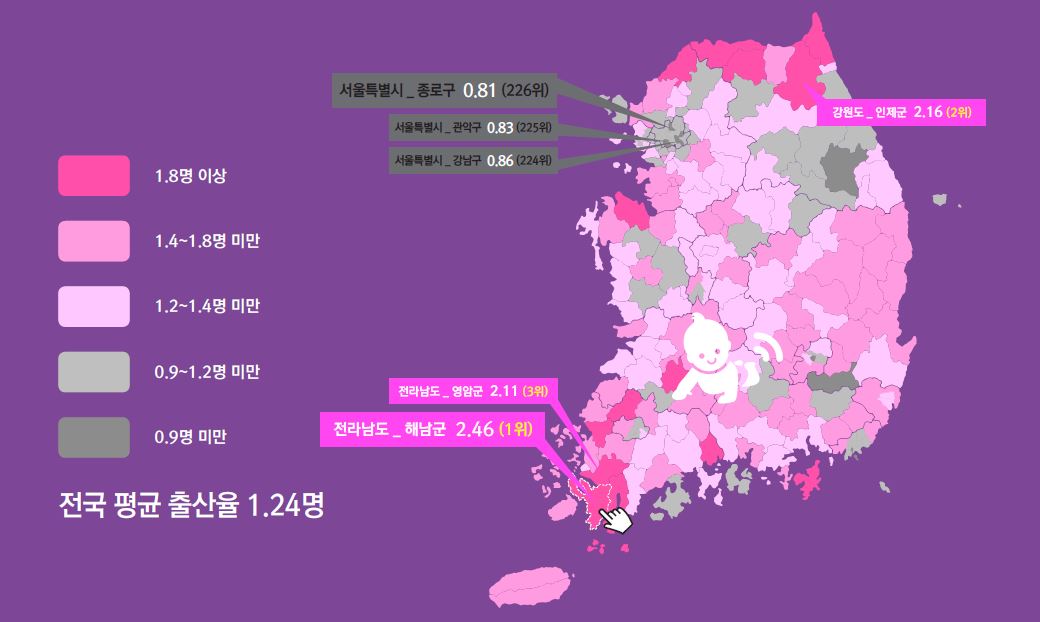
National average fertility rate in 2015.
In 2016, the Korean government released a population map of women in the childbearing age (between 20 and 44) per municipality, on its website. The map shows that the darker pink color is, the more women who can give birth there are. The government created this map to make the public aware of the seriousness of low birth rates, but this also revealed the old perspective of Korean society. This map reflected the perception of women as a “tool for childbirth,” not as an individual. Giving birth has been considered as a woman’s mandatory role in Korean society. This map gives the expansion of perspective to that women as a whole are responsible for the present low birth rate problem. The website with only pictures of women and children clearly shows the perspective that the group “men” is not related to childbirth. Eventually, the website received a lot of criticism and it was immediately stopped on the publication day. This type of idea should be considered carefully because it has the potential to create a stereotypical image of a group as a whole rather than respecting individuals.
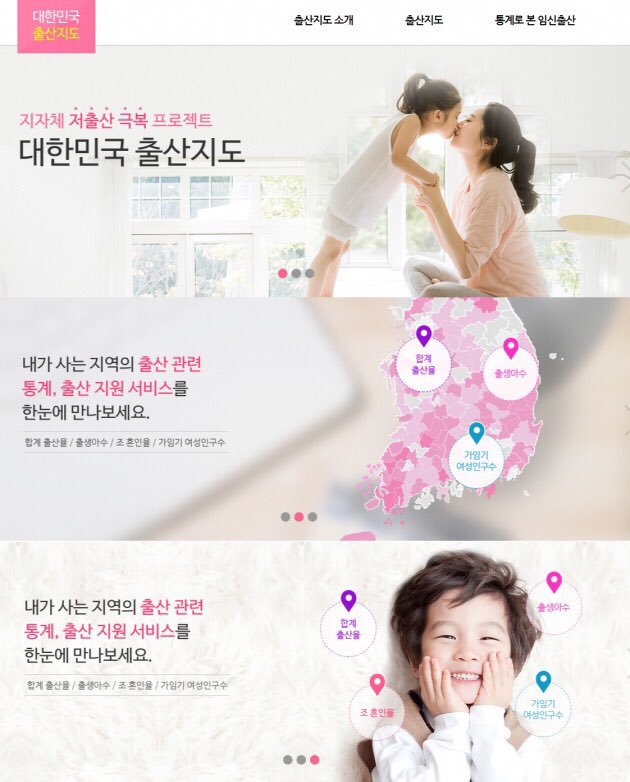
Reasons for Criticism of “Korea Birth Guidance.”
Despite the danger of grouping, in which individuals are generalized to be typical of groups, human beings instinctively desire to belong to groups. This desire is basically based on a fear of alienation. Here, in the group to which I belong, which is called “in-group,” people feel more intimacy and solidarity and therefore try to become more like the members of the group. However, because I have relatively little in common with the group to which I do not belong, called “out-group,” people distance themselves from that out-group and discriminate because they believe their own group is superior to other groups. This exclusivity solidifies the ideology of the people in the group and makes them believe that they are unique. Thus, this grouping eventually creates conflict and deepens prejudice among groups. In particular, Korea is one of the countries with a strong desire to have a sense of belonging. This appears through various categories such as nationality, family, gender, and so on. Such group-oriented thinking naturally appears around various conflict structures between groups. As I said before, humans have a natural tendency toward collectivism, but Korea's obsessive collectivism has resulted in a more magical effect on my categorical thinking. Therefore, I would like to try to find out how the category of a group was formed in Korea, how it created the structure of conflict, and how it influenced people through the historical background.
Korea which became one
Conflict, Collectivism, and Korea
In the flow of histories such as the Later Three Kingdoms, Goryeo, and Joseon, Korea has maintained its bond as a single-race nation for a long time, so the tendency of collectivism is strong. According to The study of The Influence of Korean Collectivism(Uri, we-ness) on Interpersonal Communication Behaviors, this historical background proves that it was considered as a good attitude not only to value groups based on various connections such as school relations and regionalism and be a part of them, but also to live as a ‘family’ even in groups like companies which are not based on such connections. in addition, just as Koreans enjoy using the word ‘we’ and use the expression ‘we’ even when it means ‘I,’ the collectivist sentiment of Koreans is melted into everyday language. Therefore, Korean collectivism is characterized by terms such as familism, nepotism, nationalism, patriotism, paternalism, and mainstream.5 5 Yang, J. (2019). The Influence of Korean Collectivism(Uri, we-ness) on Interpersonal Communication Behaviors. JOURNAL OF THE KOREA CONTENTS ASSOCIATION, 19(5), 3–5.
This collectivist disposition has heightened the conflict more due to the historical background of division. After independence from Japan in 1945, the Korean peninsula was divided into North Korea and South Korea by the Soviet Union and the United States along the 38th parallel. Korea remains one of the few divided countries so far. In The Study of Social Conflict Structure in Korea, it is said that after division, Korean society is still showing various and serious social conflicts and divisions between groups amid rapid economic growth and changes in social structure.6 6 Lee, B., Kim, S., & Chun, Y. (2008). The Study of Social Conflict Structure in Korea: Level, Cause and Alternative. Korean Public Management Review, 22(4), 3. https://doi.org/10.24210/kapm.2008.22.4.003

However, another study on the social conflicts in South Korea says that politicians, who had to control conflict, promote social cohesion and act as mediators, have actually amplified the conflict phenomenon. Moreover, as social conflicts accumulate as authoritarianism gives way to a democratic political system, the solution method prioritizes emotional confrontation and collective interests over rational negotiations and interest harmony.7 7 Suh, M. (2004). The Storming Upon Us: Social Conflicts in South Korea. Korean Journal of Sociology, 38(6), 3.
Here, we should take a closer look at Korea's unique concept of collectivism. According to The Study of The Influence of Korean Collectivism again, in the Western theory collectivism is a concept that groups are more important than individuals and has characteristics such as individual sacrifice for groups, the importance of harmony among group members, and preference to work as a group. However, Koreans actually tend to use groups to achieve individual goals rather than sacrifice them for group’s goals, and they seem to value forming and maintaining good relationships between themselves and other group members rather than considering harmony among group members.8 8 Yang, J. (2019). The Influence of Korean Collectivism(Uri, we-ness) on Interpersonal Communication Behaviors. JOURNAL OF THE KOREA CONTENTS ASSOCIATION, 19(5), 3–5. This seems to be for the group, but ultimately for the benefit of the individual. The use of collectivism for individual benefit and the power game between them eventually lead to social conflicts. Then, how does the power that causes this conflict work?
Media, invisible political power
According to Robert A. Dahl, power works in two ways when there is a conflict of interest between individuals or groups: by suppressing the other and achieving goals, and by intervening in decision-making to prevent conflicts from surfacing. On the other hand, Steven Lukes' the third dimension of power refers to the power to adjust the tastes and interests of the other party so that no conflict of interest occurs.9 9 Koang, J. (2012). Revisiting Michel Foucaults theory of power : Focus on a comparison with exchange theory, network theory and 3-dimensional power theory. ECONOMY AND SOCIETY, 19. Since the third dimension of power is not a direct intervention using power, mass media and education are at the center of it. Mass media, which has no form but a big influence that is universally exposed to everyone, is easy to form our perception without being noticed. Above all, it is actively showing the use of visual language. Then, in Korean society, in what way does the media use visual language and how does it reach our perception?
In Korea, there is a sentence that shows unity: “Uriga Namiga(우리가 남이가)?” This means “we are not strangers,” or “we are a family.” This sentence implies the community spirit of Korean collectivism, so it has been reproduced in a similar context within communities, social networks, and all kinds of other media. The reason why the media continue to use this characterization of collectivism is that there remains a stereotype of a collectivist idea even now that individuals are more valued.
Professor Seung-woo Jeon analyzed in a forum titled Asking Samsung Again that Samsung, the most powerful company in Korea, promoted its products with a focus on collectivism. From 1988 to 1997, Samsung introduced its new slogan ‘World’s First-Class’ to broaden the business outside of Korea. They promoted themselves as a national sports team member representing ‘Korea, Strong in the World.’ Under the name “Korea,” they not only reminded us of the power of nation’s unity but also made them appear to have enhanced the quality of their technology. Professor Jeon said in the forum, “Samsung delivered a message that each citizen needs to try to be the world's first-class, and this is a way to patriotize the country and a shortcut to a happy developed country.” As the center of power switched from the government to chaebols after the period of “development dictatorship,” the methodology of commercials has also changed in line starting from the 1990s.

Samsung Advertisement that highlighted competition and professionalism under the slogan of 'World-class' - from 1988 to 1997
In the process of this change, Asian Financial Crisis took place in 1997 and this effectively showed the positive direction of collectivism. It was a historic incident in which about 3.51 million people across the country voluntarily collected 227 tons of gold in just two months to overcome the crisis. On the other hand however, phenomena such as mass unemployment, intensifying competition and collapse of the middle class followed the IMF’s bailout, and traditional families were also dismantled. Here Samsung tried to build a bond between companies and consumers by using a friendly looking clay animation to send messages of importance of the meaning of family under the slogan "Another Family.” In the midst of a social phenomenon in which traditional family values collapsed, Samsung, which had great power and recognized the power of commercials, did not miss the opportunity and attempted to group people into “family.” This campaign received a great positive feedback from the public so the series were made for 10 years, and it has served as an opportunity to increase familiarity and favorability for Samsung.10 10 Lee, J. (2014, February 10). The reason why Samsung abandoned ‘another family’ and went to ‘transnationalism.’ Mediatoday. Retrieved March 12, 2022, from http://www.mediatoday.co.kr/news/articleView.html?idxno=114729
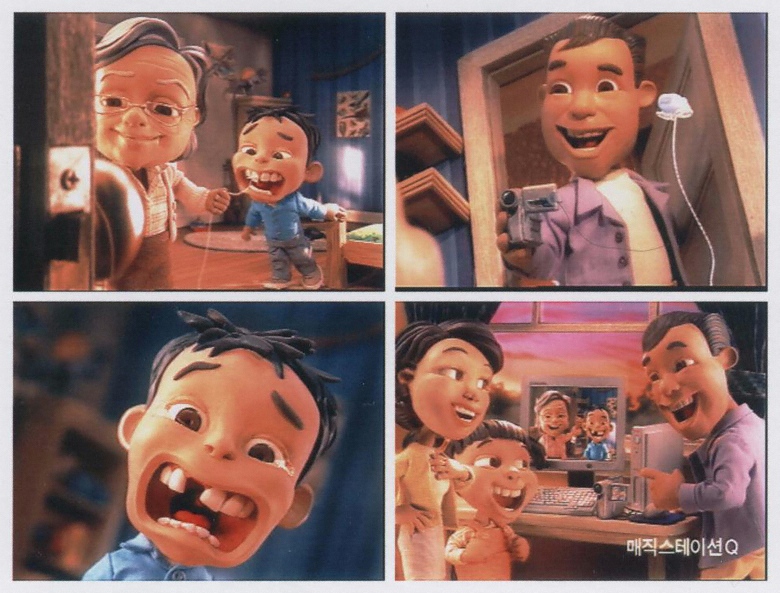
Samsung advertisement with the slogan of ‘Another Family’ representing the union between the traditional family and technology in the reality of strengthening familism - from 1997 to 2007
Therefore, companies benefit from touching the collectivist perception of unconsciously embedded people. Looking at the results of the tendency of collectivism, which is gradually layered due to the historical background and media influence in the minds of Koreans, I could find the results of this as a social phenomenon called a ‘uniform culture.’ For the Korean culture where a person has to find identity within a group, the phenomenon can be understood with visual evidence of the following research.
Uniform culture which binds us
The visual research was initiated through a social phenomenal analysis of how stereotypical images, the result of categorical thinking, made people uniform. In addition, I also had the research question of “How can we see collectivism in Korea visually?” While collecting images about stereotypes, I found uniforms are used a lot in Korean society. Since Korea, which has a dominant collectivist tendency, prefers a unified form of appearance, uniforms are used in various fields of work. Usually, uniforms are used to emphasize expertise, create group unity, and give people a sense of belonging. But on the other hand, it can suppress someone’s individuality. Even though there is a risk of losing individuality, some social groups in Korea still prefer this uniform culture because they are afraid of degradation of the group’s identity. School uniforms that are mandatory in many schools show how Korean society educates people with standardization. They have been utilized continuously since modernization but there was also a period of liberalization in the 1980s. However, society still believed there should be an ideal image of “studentness” so students had to wear the uniforms again shortly after.
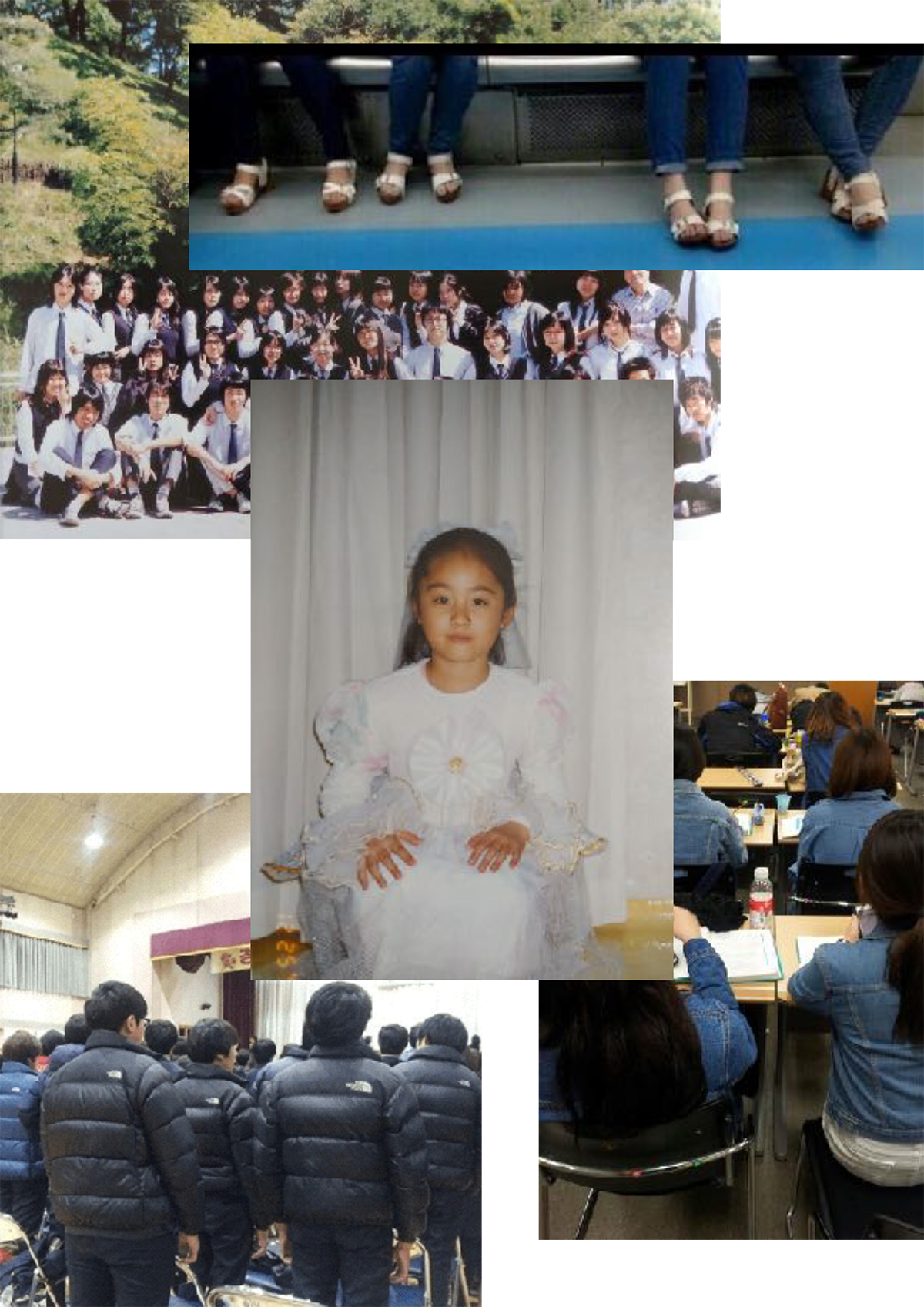
While collecting traces of uniforms from my childhood in the photo album, I could find not only uniforms but also stereotypical clothes for girls such as typical princess dresses which standardized my taste. After graduation we become free to make our own choices, but we are still used to the unity buying trendy clothes with the same tastes as others. Would standardized clothes that fit a typical image not really affect our perception in the future or make it difficult to find individual tastes? Would we have changed if culture and education respected individuality since childhood? Will it be possible to deviate from the cycle of categorization in the inseparable collectivism to find individuality?
Confusion between group identity and individual identity is more clear in cultures with strong collectivism, but it also appears in any culture. If we look at the Exactitudes series that photographer Ari Versluis and profiler Ellie Uyttenbroek have been working on since 1994, we can see how humans are uniformed in an unstable and complex social environment. Their photo series reveals the apparent contradiction between the desire to differentiate ourselves and the desire to belong to a particular group through categorization of the same dress code.11 11 Versluis, A., & Uyttenbroek, E. (2002). Exactitudes. Retrieved March 27, 2022, from https://exactitudes.com/
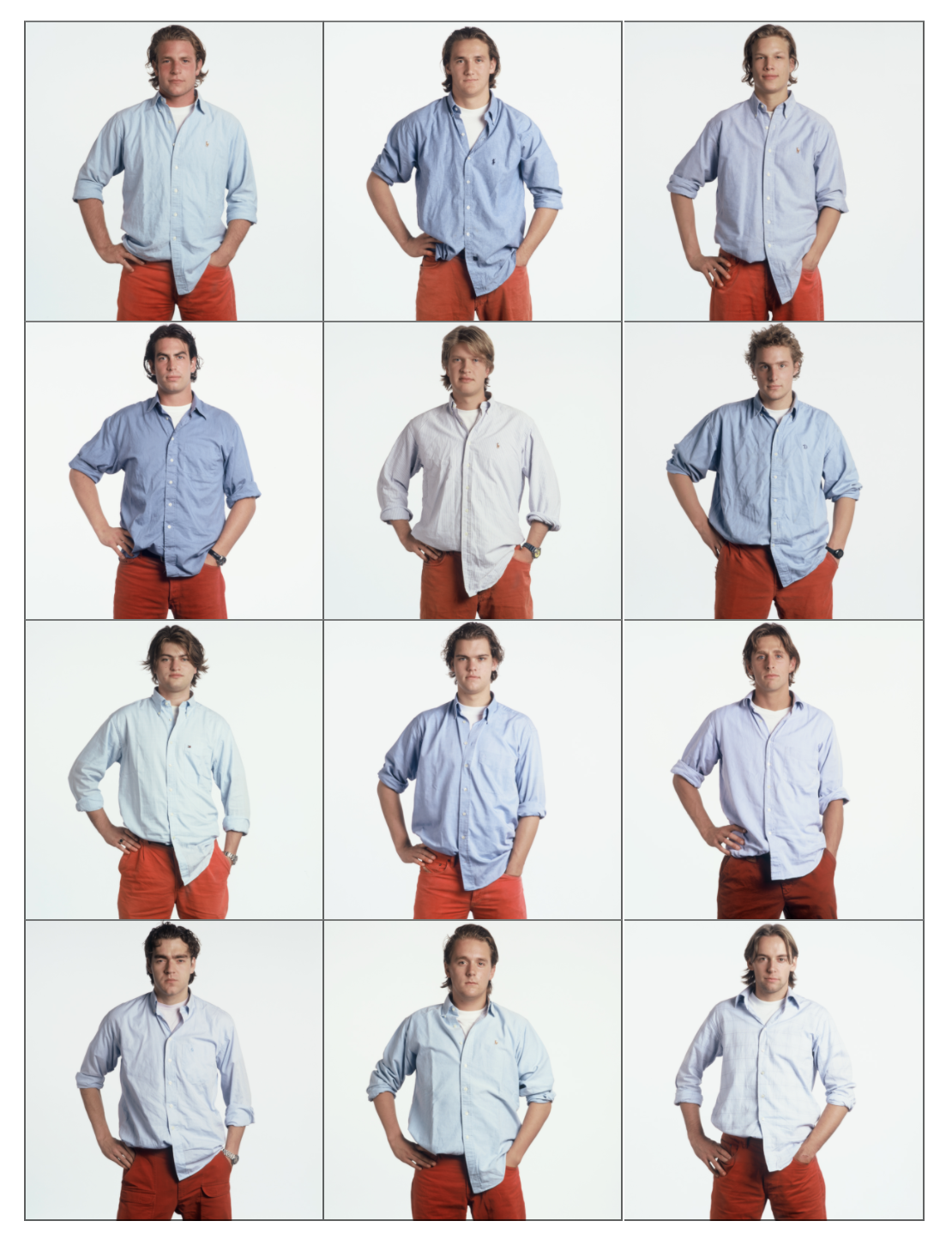
Exactitudes by Ari Versluis and stylist Ellie Uyttenbroek
An individual who is unable to escape from a group and the instinctive habit of attempting to resemble others, raises a question about human beings' unique identity. Then, how can we recover our individuality from the cycle of categorizing ourselves into groups? We all have craving for groups, which creates categorization that can summon the dangers of categorical thinking at any time. Then, how do I think of the right direction of design in the midst of the swamp of categorical thinking and its dangers, strong collectivism that causes conflict and uniformity? Can I get closer to the answer if I look into projects that are wary of categorical thinking and have an open mind about diversity?
Challenge for de-categorization
The Annex of Universal Languages
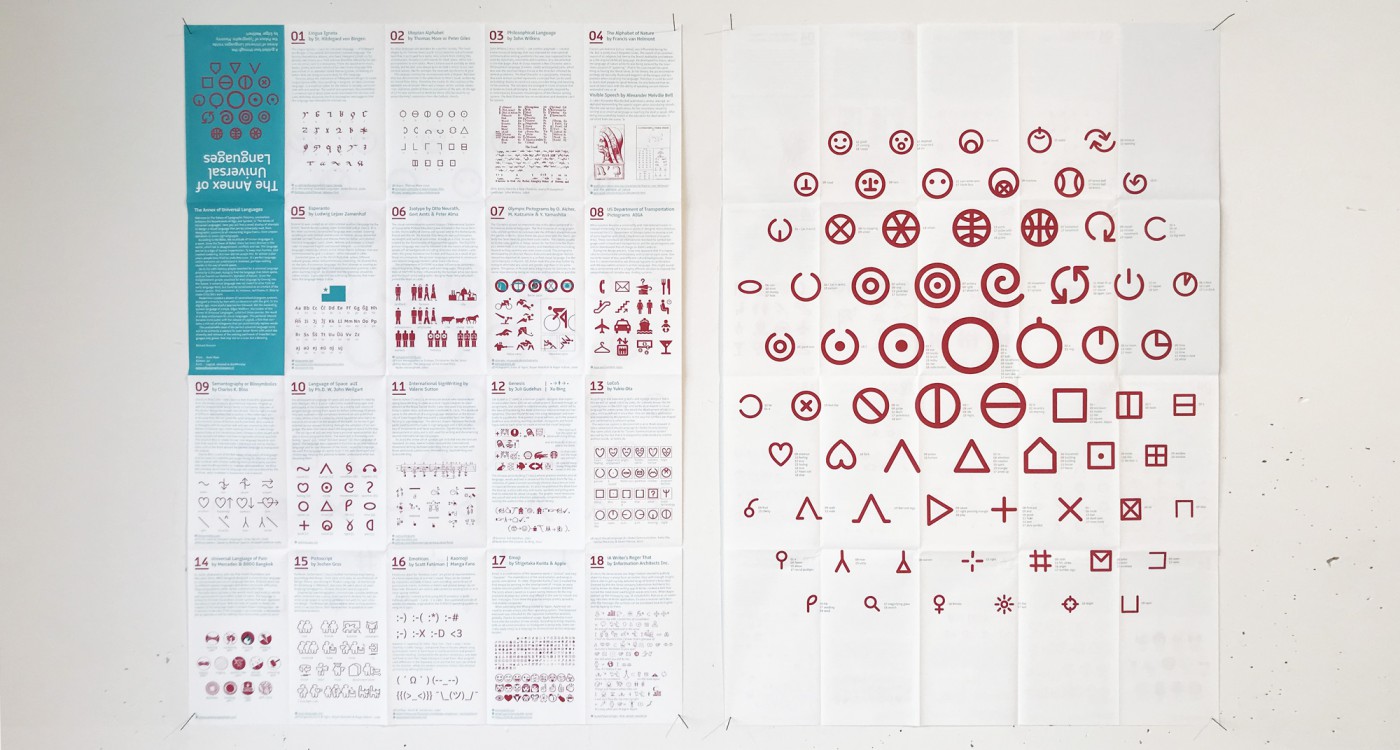
The Annex of Universal Languages by Edgar Walthert
In the first chapter, I mentioned that universal formative languages such as toilet signs have a problem of reductionism due to stereotypes about categorical typicality. And it is not easy with them to contain all other cultural aspects simply but comprehensively. Regarding this, the project The Annex of Universal Languages by Edgar Walthert who initiated this with a longing for a perfect and universal language is a meaningful study attempted without fear of challenge. He collected historical examples of design for symbol-based universal languages. Then he made a diagram that shows similar symbols from each of the visual languages; however, none of the visual language systems had a common universality. This is because these symbols are read differently depending on perception or cultural background. Therefore, it is not easy to escape from the typical image we already have. However, by revealing this utopian ideal about the universal language, I think he could become more open to a diversity of language systems.
Believe in the greatness of yourself
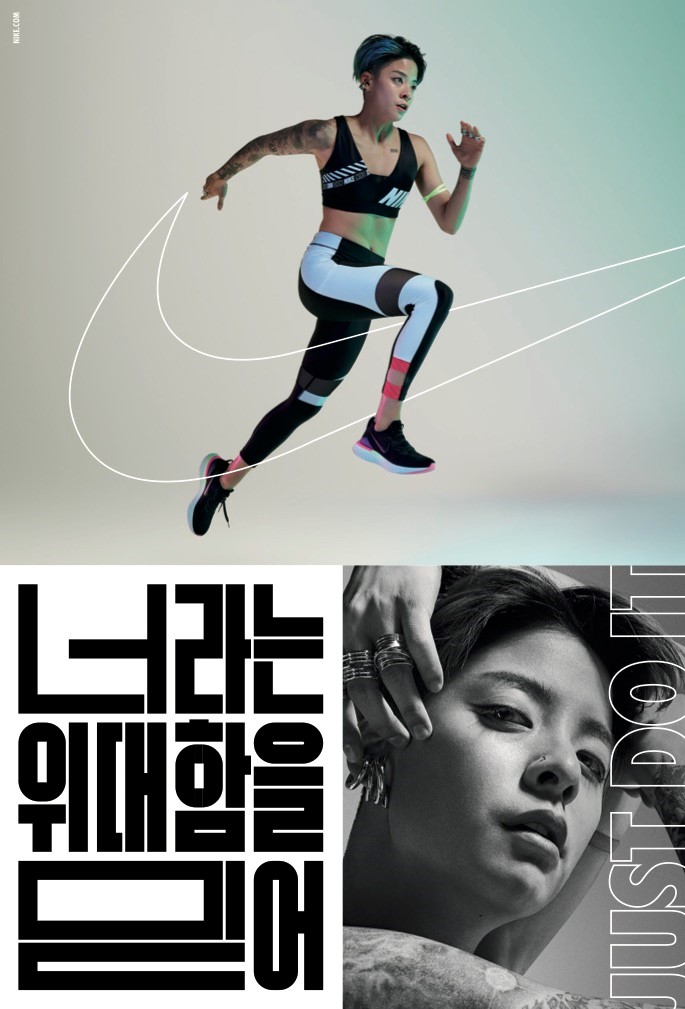
Nike Korea Women’s Just Do It campaign advertisement in 2019
People who are tired of “unity” and one fixed image are turning to give value to themselves. They think it's no longer strange to do something alone and try to find the “center” from themselves. In 2019, Nike launched “Women’s Just Do It” campaign world-wide, and Nike Korea used a storyline similar to original commercials but applied accordingly to local culture and social problems of Korea. In the commercial, they sent a message: "Believe in the greatness of yourself." to encourage women's independent life in their life. All women working in various fields appear as main characters, and they actively show their own individuality beyond the frame of traditional gender roles. Due to the scene with the message that "my body belongs to me,", it brings a misogyny crime case that was a big social issue in Korea. Women who have been thoroughly otherized and objectified in the patriarchal society, now tell someone beyond the camera that their stories are about us all. Since the contents related to women's rights have almost never been dealt in pop culture in Korea, the impact of the commercial was huge and the favorability of the company has highly increased. Considering the structure of the advertising industry that needs to capture people in a very short time, there is a possibility that this will end up as a one-off event. However, showing a variety of people who deviate from the fixed image in the media eventually affects the random public, so I think the way they show is a necessary step, whether small, large, or PC(politically correct).
Multi-form
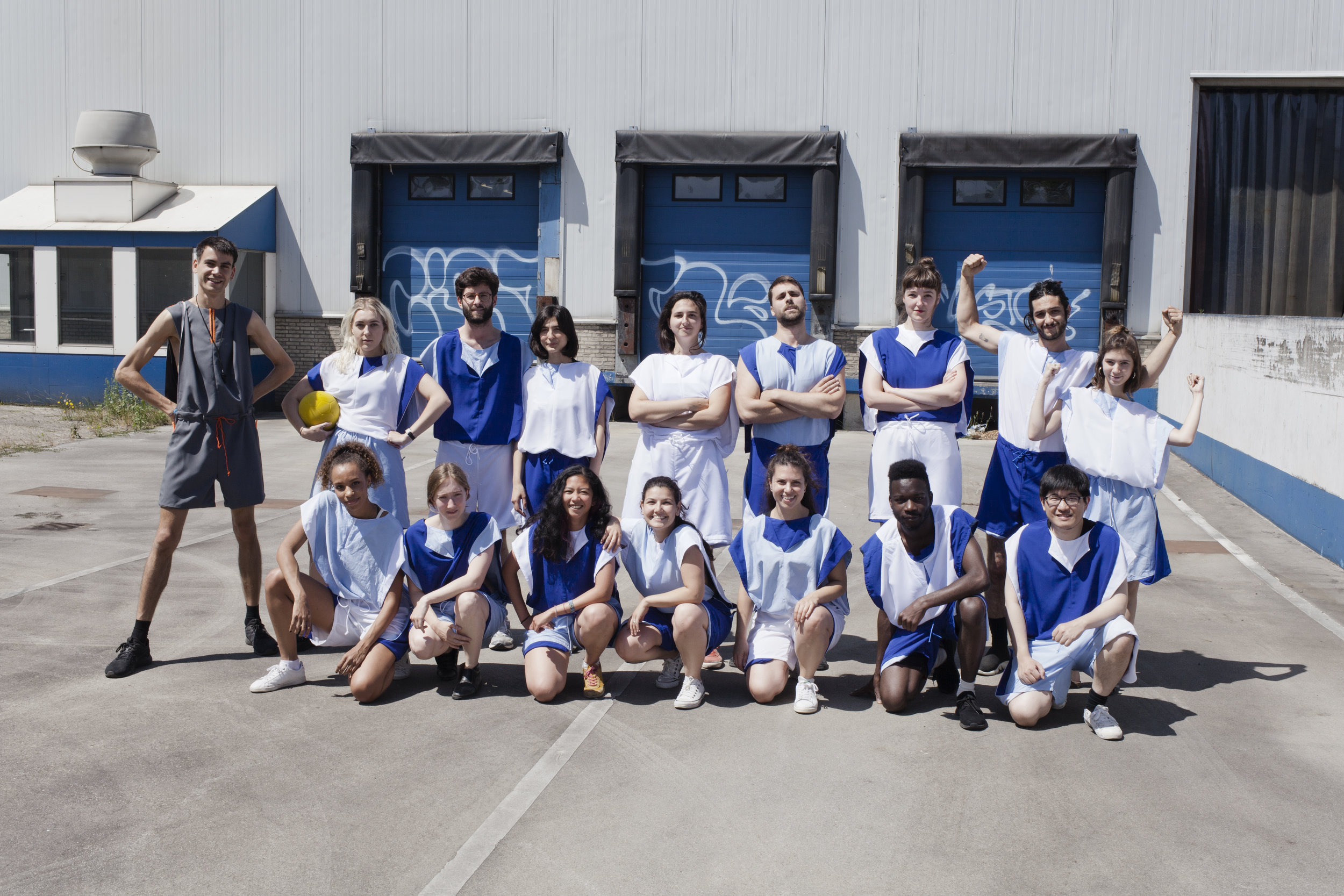
The project MULTIFORM developed by Studio Fontana.
Next example to show an attempt to cross the boundaries of normative aspects is the project MULTIFORM developed by Studio Fontana. The project is an ongoing design research that questions and re-invents the social and political role of sport in contemporary society. Consisting of new uniforms, sports games and objects, these whole kits play the role to provide innovation for discussion about diversity within education. The game consists of three teams in total. Each team needs to defend the goal from the other teams and attack. However, when the referee blows the whistle in the middle of the game, they need to transform their clothes according to that signal. Teammates keep changing by the color or form of their clothes. Because of the uniform that keeps transforming, the distinction between teams becomes meaningless and the boundaries disappear. Beyond just deconstructing the artefact of the uniform itself, MULTIFORM aims to radically question the normative aspect of design that constantly shapes our daily social interaction and perception.12 12 Studio Fontana. MULTIFORM. (n.d.). MULTIFORM. Retrieved March 12, 2022, from https://www.multi-form.org/ The designer used more performative design research here considering his own body as a research tool. And he tried to analyze people's behavior in social norms through body research.13 13 Termenón, I. (2020, May). Social Designer Gabriel Fontana Wants to Change How We Play Team Sports with MULTIFORM. True to Size. Retrieved March 12, 2022, from https://www.fitstruetosize.com/social-designer-gabriel-fontana-multiform-rotterdam/
Complete de-categorization remains a utopian dream, but challengers' efforts to mix diversity in a society where stereotypes abound have resulted in several progressive questions and answers. I think the most active de-categorization is to recover the individuality that has been fixed and simplified by categorization in collectivism. If we make design decisions in an attitude of respecting and accepting various aspects of an individual beyond the typicality of a group, wouldn't we be able to care about problems such as simplification, prejudice, stereotypes, discrimination, conflict, and uniformity? And if we minimize these problems, wouldn't we be able to choose the best direction of design when turning ideas into visual language? However, if we reflect on our inherently categorical thinking, particularly ego which has a strong collectivist tendency, it is still difficult for us to completely escape from the danger of categorical thinking. Although the research was conducted with the hope of de-categorization, categorization could have been made during this research. That's why we have to constantly practice swimming flexibly in and out of this categorization.
Conclusion
Foucault understood art, modern art in particular, as an anticultural force, one that harbored the capacity to oppose unwarranted consensus, question our habits, and posit new values. If the role of politics is to find answers, the role of art is to ask questions.14 14 Hutchens, B. C. (2010). Foucault’s Philosophy of Art: A Genealogy of Modernity. https://doi.org/10.1093/fs/knq056
As Foucault said, significance is born from continuing to ask questions about the phenomena surrounding us. Questions about me as a stranger, thoughts about belonging, generalization of identity and categorical thinking that discriminates against it were the starting points of the journey to find significance. The essential process for surviving, which is categorization, leads to the dangers of simplified, typified, grouping, stereotyping, etc. People instinctively group because everyone wants a sense of belonging, but Korea's sticky collectivism creates conflict, which is the other side of a sense of belonging. The secret act of power, which is mass media, uses the idea of collectivism to benefit from the back of the conflict. And rigid Korean collectivism through which people are eager to be one does not allow individuality. Therefore, “uniform culture” reflects the elimination of individuality resulting from the dangers of categorization. Despite this negative phenomenon of categorization and group uniformity, attempts to the restoration of individuality such as the universal language, belief in one's own greatness and multi-form show the direction and attitude we should pursue as designers or communicators. Complete de-categorization is a utopian story, but the way it is realized is not utopian.
In a way, I have a collectivist background and think it is a natural result that I felt uncomfortable and had primitive questions about categorization in this social system that values the unity of the group. But this is not just the case from my side only, but it can be to all. For example, we are all unconsciously exposed to the media and influenced by political ideals with different positions. We continue to think categorically, and in many moments that we don't recognize, we fall into a swamp of stereotypes. They dazzle and re-fix our minds back with familiar forms, colors and roles. However, in this delusion of typicality, we hope to enlighten borderless utopia and dream of the right categorization. Categorical thinking, the main culprit of stereotypes, is indispensable, so it is inevitable to accept it, so it should be able to freely cross the gaps between different categories. Understanding sounds like an ideal dream that can never come true because each person has lived in a different way. Therefore, the dangers of categorical thinking are inevitable, but wouldn't we be able to continue to discover possibilities for the best decision of design if we recognize those dangers and swim flexibly among categorizations? And if we could swim in that space composed of categorical thinking, wouldn't we be able to keep asking questions about de-categorization even if we couldn't find a clear answer about it? Since categorical thinking is one of the undeniable sources of communication, isn't flexibility the best way to use categorical thinking as an appropriate source of communication? The creation eventually consists of the artist's perception, and the outcome provides a place for mutual exchange of perceptions that each other has. I hope everyone will be actively swimming in categorization, and use the categorization zone as a place for mutual exchange of perceptions. Finally, reflecting on this research, I expect to have a clear perception to find the right direction in my design discipline in this uniform categorical thinking.
Bibliography
Chien, G. (2021, April 6). Semiotics, Social Change, and the Curious Case of the Restroom Sign. Linkedin. Retrieved March 12, 2022, from https://www.linkedin.com/pulse/semiotics-social-change-peculiar-history-restroom-sign-ginger-chien
Hutchens, B. C. (2010). Foucault’s Philosophy of Art: A Genealogy of Modernity. https://doi.org/10.1093/fs/knq056
Hwang, J., Kim, D., Shin, H., Yi, J., & Kim, H. (2012). The Effect of the Evaluator Group on the Self-Stereotyping of the Southeast-Asian Immigrants in the Context of Multiple Social Identities. THE KOREAN JOURNAL OF SOCIAL AND PERSONALITY PSYCHOLOGY, 26(1), 124. https://doi.org/10.21193/kjspp.2012.26.1.008
Kim, S. (2018, December 16). [Shin Kim's 'Thank You Design'] Beware of reductionism in pictograms. Weekly empathy. Retrieved March 12, 2022, from https://gonggam.korea.kr/newsView.do?newsId=01IctLbYDGJMP000&pageIndex=1
Koang, J. (2012). Revisiting Michel Foucaults theory of power : Focus on a comparison with exchange theory, network theory and 3-dimensional power theory. ECONOMY AND SOCIETY, 19.
Langhe, B. de, & Fernbach, P. (2019). The dangers of categorical thinking. Harvard Business Review. Retrieved March 12, 2022, from https://hbr.org/2019/09/the-dangers-of-categorical-thinking
Lee, B., Kim, S., & Chun, Y. (2008). The Study of Social Conflict Structure in Korea: Level, Cause and Alternative. Korean Public Management Review, 22(4), 3. https://doi.org/10.24210/kapm.2008.22.4.003
Lee, J. (2014, February 10). The reason why Samsung abandoned ‘another family’ and went to ‘transnationalism.’ Mediatoday. Retrieved March 12, 2022, from http://www.mediatoday.co.kr/news/articleView.html?idxno=114729
Studio Fontana. MULTIFORM. (n.d.). MULTIFORM. Retrieved March 12, 2022, from https://www.multi-form.org/
National average fertility rate in 2015. (n.d.). [Graph]. http://m.biz.khan.co.kr/imageviewer.html?art_id=201609161221001&is=2
Reasons for Criticism of “Korea Birth Guidance.” (n.d.). [Graph]. https://news.v.daum.net/v/20161229170606575
Suh, M. (2004). The Storming Upon Us: Social Conflicts in South Korea. Korean Journal of Sociology, 38(6), 3.
Termenón, I. (2020, May). Social Designer Gabriel Fontana Wants to Change How We Play Team Sports with MULTIFORM. True to Size. Retrieved March 12, 2022, from https://www.fitstruetosize.com/social-designer-gabriel-fontana-multiform-rotterdam/
The 38th parallel. (n.d.). [Photograph]. https://thewiki.kr/rev/
%EC%82%BC%ED%8C%94%EC%84%A0/!0
Versluis, A., & Uyttenbroek, E. (2002). Exactitudes. Retrieved March 27, 2022, from https://exactitudes.com/
Walthert, E. (n.d.). The Annex of Universal Languages [Photograph]. https://ewalthert.com/icons
Yang, J. (2019). The Influence of Korean Collectivism(Uri, we-ness) on Interpersonal Communication Behaviors. JOURNAL OF THE KOREA CONTENTS ASSOCIATION, 19(5), 3–5.
Hyeonjeong Joo, KABK 2022
Under the supervision of Dirk Vis, François Girard-Meunier and Thomas Buxo